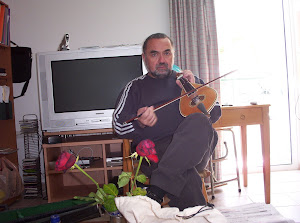Nasser Taghvaï, Wind of Jinn (Bad-e Jen) (1969)
Δεν μπορώ να πω ότι το ντοκιμαντέρ είναι το
αγαπημένο μου είδος, παρόλο που έχω δει καταπληκτικά ντοκιμαντέρ. Όμως καθώς
είμαι φαν του ιρανικού κινηματογράφου, βλέπω κάθε ιρανική ταινία που θα βρω. Τον
«Άνεμο του Τζιν» μου τον υπέδειξε ο facebook
φίλος μου Hoji
Fred
. Η ταινία βρίσκεται
στο youtube και μπορείτε να τη δείτε. Είναι η τρίτη
ταινία που βλέπω του Nasser
Τaghvai
, μετά
την «Ησυχία
μπροστά στους άλλους» και «Κάπτεν Χουρσίτ» (Η δεύτερη είναι μεταφορά του
μυθιστορήματος του Χεμινγουέη «Να έχεις και να μην έχεις»). Είναι χωρίς
υπότιτλους, όμως μπορεί άνετα να την παρακολουθήσει κανείς.
«Ο άνεμος του Τζιν» τοποθετείται στο νότιο
Ιράν και δείχνει τις προλήψεις για τον κακό άνεμο που επιδρά πάνω στους ντόπιους
και πρέπει να απομακρυνθεί με ένα ειδικό τελετουργικό. Το ντοκιμαντέρ δείχνει
σκηνές από αυτό το τελετουργικό. Αφηγητής είναι ο πέρσης ποιητής Αχμάντ Σαμλού. Από όλη
την αφήγηση μόνο τη λέξη «ντουνιά» κατάλαβα.
Αμέσως από κάτω έχω την περίληψη στα αγγλικά,
και κατόπιν παραθέτω ένα άλλο σχετικό κείμενο που βρήκα ψάχνοντας στη google
για την ταινία στην ιστοσελίδα www.academia.edu
The Wind of Jinn (Bad-e Jen) is set in Southern Iran and
shows a close portrayal of beliefs in the Jinn (evil) wind which afflicts
locals and must be removed in a special ritual. In the southern ports region of
Iran, especially in Bandar Abbas and Bandar Lengeh areas, it is believed that
the "Wind of Jinni" affects the life of people, scattering them
through the world and causing many emigrations.The people afflicted with the
Wind of Jinni are called the "The Weathered" and special rituals are
performed to cure them. The film presents scenes of the Wind of Jinni rituals.
With narration by Persian poet Ahmad Shamlou.
Can Winds Be
Settled: Zar (spirit possession ritual) in Iranian Ethnographic Films
Introducer of Lecturer: Dr. ItsushiKawase
Speaker
Dr.P. Khosronejad, Department of Social Anthropology, University of St
Andrews, Scotland/Associated member GroupeSociétés, Religions, Laïcités, GSRL/CNRS-Paris
Venue: National Museum of Ethnology, Osaka, Japan, 26th July
2012, 14:00 pm
Beside Shiite healing ceremonies, performed mostly among urban societies,
in Iran one can still find many healing and spirit rituals and ceremonies
which have some connection with popular beliefs but which are not based on
Islamic thought or religious texts.
One of the most notable of these customs is Zar. Based on direct
observations in the field, speaker believes that zar belongs to one of the
two kinds of popular spiritual healing practices among non-urban societies
of Iran. From Abadan to Chabahar, different ethnical groups practice and
perform zar as a spirit possession ceremony and healing ritual for curing
sufferings that are created mostly by supernatural entities, in the
majority of cases, jinns. Some of these jinns can penetrate the body of
local people and change the nature of their spirit, their soul and
consequently their normal life. After local beliefs, the only way to be at
peace with such extra-human forces is to perform the zar ritual.
While we do not have much information or academic reports on zar before the
Iranian revolution of 1978-79, after this period, surprisingly, we start
seeing more images about this sprit possession ceremony in Iranian
ethnographic films.
In this lecture speaker will discuss and analyze how Iranian documentary
filmmakers capture and present Zar ceremonies and compare them with similar
ethnographic films made about sprit possession rituals in other cultures.
Iranian films which will be disused:
Taghvayi, Nasser (1969). Jinns’s Wind/Bad-e Jen/ 21.53’/ Iran.
Oskoui, Mehrdad (2004). The Other Side of Burka (Az pas-e Burqeh) / 52’ /
Iran.
Rahmani, Mahmud (2007). The Zero Degree Orbit (Madar-e Sefrdarajeh) / 26’ /
Iran.
This lecture will be continued by projection and analyze of documentary
film “The Other Side of Burka” made by Mehrdad Oskoui
|
|








No comments:
Post a Comment